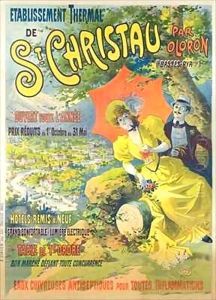Lucien Baylac Paintings
Lucien Baylac was a French artist, born in 1851 and passing away in 1913. Although not as widely recognized as some of his contemporaries, Baylac made significant contributions to the art world during his lifetime, particularly in the realm of poster art and illustration. His work is characteristic of the Belle Époque period, a golden age of French culture and art that flourished from the late 19th century until World War I.
Baylac's artistic journey began in his early years, showing a natural talent for drawing and painting. He pursued formal art education, which was a common path for artists of his era, enabling him to refine his skills and develop a distinct style. Baylac was particularly influenced by the Art Nouveau movement, which was gaining popularity during his formative years as an artist. This movement, known for its organic forms and decorative styles, is evident in Baylac's approach to composition and his use of color and line.
Throughout his career, Lucien Baylac specialized in creating posters and illustrations, a medium that was becoming increasingly popular for advertising and communication in the bustling urban centers of France. His works often featured vibrant colors and dynamic compositions, capturing the viewer's attention with their elegance and detail. Baylac's contributions to poster art were part of a broader movement that included artists like Henri de Toulouse-Lautrec and Jules Chéret, who were also exploring the potential of this art form to captivate and communicate.
In addition to his poster art, Baylac produced illustrations for books and magazines, contributing to the visual culture of the Belle Époque. His illustrations often depicted scenes of everyday life, as well as fantastical elements, showcasing his versatility as an artist and his ability to capture the imagination of his audience.
Despite his contributions to the art of his time, Lucien Baylac's work has not received the same level of recognition as some of his peers. However, his art remains a valuable part of the history of French illustration and poster design, offering insight into the aesthetic preferences and cultural trends of the Belle Époque era. Baylac's legacy continues to be appreciated by art historians and collectors who recognize his skill and the beauty of his work.

